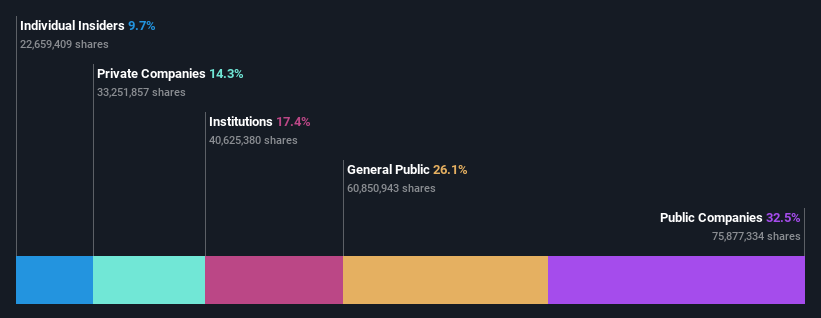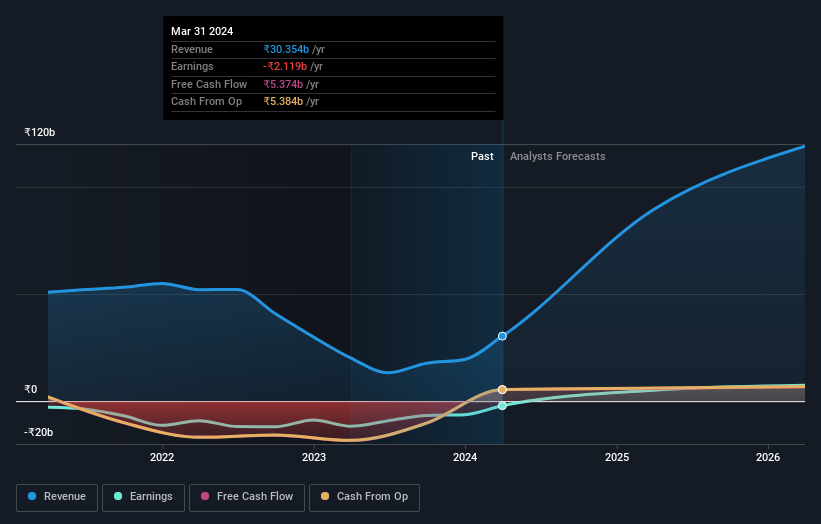- India
- /
- Construction
- /
- NSEI:SWSOLAR
Sterling and Wilson Renewable Energy Limited's (NSE:SWSOLAR) market cap dropped ₹7.8b last week; Public companies bore the brunt

Key Insights
- Significant control over Sterling and Wilson Renewable Energy by public companies implies that the general public has more power to influence management and governance-related decisions
- A total of 3 investors have a majority stake in the company with 52% ownership
- Insiders have been selling lately
A look at the shareholders of Sterling and Wilson Renewable Energy Limited (NSE:SWSOLAR) can tell us which group is most powerful. The group holding the most number of shares in the company, around 33% to be precise, is public companies. In other words, the group stands to gain the most (or lose the most) from their investment into the company.
And last week, public companies endured the biggest losses as the stock fell by 4.2%.
Let's delve deeper into each type of owner of Sterling and Wilson Renewable Energy, beginning with the chart below.
Check out our latest analysis for Sterling and Wilson Renewable Energy

What Does The Institutional Ownership Tell Us About Sterling and Wilson Renewable Energy?
Many institutions measure their performance against an index that approximates the local market. So they usually pay more attention to companies that are included in major indices.
We can see that Sterling and Wilson Renewable Energy does have institutional investors; and they hold a good portion of the company's stock. This suggests some credibility amongst professional investors. But we can't rely on that fact alone since institutions make bad investments sometimes, just like everyone does. It is not uncommon to see a big share price drop if two large institutional investors try to sell out of a stock at the same time. So it is worth checking the past earnings trajectory of Sterling and Wilson Renewable Energy, (below). Of course, keep in mind that there are other factors to consider, too.

Sterling and Wilson Renewable Energy is not owned by hedge funds. Looking at our data, we can see that the largest shareholder is Reliance Industries Limited with 33% of shares outstanding. For context, the second largest shareholder holds about 13% of the shares outstanding, followed by an ownership of 7.0% by the third-largest shareholder. Khurshed Daruvala, who is the third-largest shareholder, also happens to hold the title of Chairman of the Board.
A more detailed study of the shareholder registry showed us that 3 of the top shareholders have a considerable amount of ownership in the company, via their 52% stake.
While studying institutional ownership for a company can add value to your research, it is also a good practice to research analyst recommendations to get a deeper understand of a stock's expected performance. While there is some analyst coverage, the company is probably not widely covered. So it could gain more attention, down the track.
Insider Ownership Of Sterling and Wilson Renewable Energy
While the precise definition of an insider can be subjective, almost everyone considers board members to be insiders. The company management answer to the board and the latter should represent the interests of shareholders. Notably, sometimes top-level managers are on the board themselves.
I generally consider insider ownership to be a good thing. However, on some occasions it makes it more difficult for other shareholders to hold the board accountable for decisions.
We can see that insiders own shares in Sterling and Wilson Renewable Energy Limited. This is a big company, so it is good to see this level of alignment. Insiders own ₹17b worth of shares (at current prices). If you would like to explore the question of insider alignment, you can click here to see if insiders have been buying or selling.
General Public Ownership
With a 26% ownership, the general public, mostly comprising of individual investors, have some degree of sway over Sterling and Wilson Renewable Energy. While this group can't necessarily call the shots, it can certainly have a real influence on how the company is run.
Private Company Ownership
Our data indicates that Private Companies hold 14%, of the company's shares. Private companies may be related parties. Sometimes insiders have an interest in a public company through a holding in a private company, rather than in their own capacity as an individual. While it's hard to draw any broad stroke conclusions, it is worth noting as an area for further research.
Public Company Ownership
We can see that public companies hold 33% of the Sterling and Wilson Renewable Energy shares on issue. This may be a strategic interest and the two companies may have related business interests. It could be that they have de-merged. This holding is probably worth investigating further.
Next Steps:
It's always worth thinking about the different groups who own shares in a company. But to understand Sterling and Wilson Renewable Energy better, we need to consider many other factors. For instance, we've identified 2 warning signs for Sterling and Wilson Renewable Energy that you should be aware of.
If you are like me, you may want to think about whether this company will grow or shrink. Luckily, you can check this free report showing analyst forecasts for its future.
NB: Figures in this article are calculated using data from the last twelve months, which refer to the 12-month period ending on the last date of the month the financial statement is dated. This may not be consistent with full year annual report figures.
New: Manage All Your Stock Portfolios in One Place
We've created the ultimate portfolio companion for stock investors, and it's free.
• Connect an unlimited number of Portfolios and see your total in one currency
• Be alerted to new Warning Signs or Risks via email or mobile
• Track the Fair Value of your stocks
Have feedback on this article? Concerned about the content? Get in touch with us directly. Alternatively, email editorial-team (at) simplywallst.com.
This article by Simply Wall St is general in nature. We provide commentary based on historical data and analyst forecasts only using an unbiased methodology and our articles are not intended to be financial advice. It does not constitute a recommendation to buy or sell any stock, and does not take account of your objectives, or your financial situation. We aim to bring you long-term focused analysis driven by fundamental data. Note that our analysis may not factor in the latest price-sensitive company announcements or qualitative material. Simply Wall St has no position in any stocks mentioned.
Have feedback on this article? Concerned about the content? Get in touch with us directly. Alternatively, email editorial-team@simplywallst.com
About NSEI:SWSOLAR
Sterling and Wilson Renewable Energy
Engages in the provision of engineering, procurement, and construction (EPC) services to solar power projects.
Flawless balance sheet with high growth potential.


